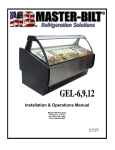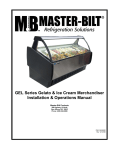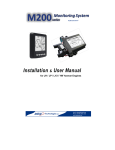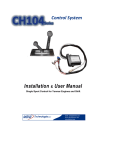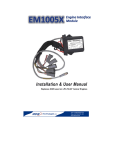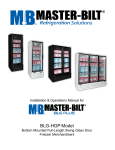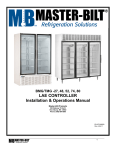Download Master Bilt LAE Controller BMG/TMG 74 s Service manual
Transcript
Installation & Operations Manual for BMG-A & BLG-HDA Self-Contained Glass Door Merchandisers With Lighted Graphic Panels Featuring LAE Electronic Controller PN 57-01892 Rev 02-03-11 TABLE OF CONTENTS INTRODUCTION………………………………….……………………………………………………………………..……………3 STORE CONDITIONS………………………….……………….…..…………………………………………………...................3 WARNING LABELS AND SAFETY INSTRUCTIONS………..…..…………………………………………………..………….3 GENERAL INSTRUCTIONS……………………………………………………………………………………………..………….4 MECHANICAL……………………………………………………………………………………………………………..………….5 REFRIGERATION CONTROL……………...……………………………………………………………………………..……...6-7 SERVICE INSTRUCTIONS…………………………………..…………………………………………………………..………….8 TROUBLE SHOOTING……………………………………………………………………………………………………..………..8 CHECK LIST……………………………………………………………………………………………………………………..……9 CABINET CLEANING PROCEDURES…………………………………………………………………………………..……...…9 Cabinet Monthly Checklist…………………..……………………………………………………..……………...……10 PART LIST…………….…………………………………………………………………..………………………………...……….10 ACCESSORIES……….…………………………………………………………………..………………………………...……….11 SALE AND DISPOSAL…………………………………………………………………..………………………………...……….11 SIGN SCHEMATICS..……………………………………………………………………………………………………………….11 BMG WIRING DIAGRAM.……………………………………………………………….……........................................………12 BLG WIRING DIAGRAM...………………………………………………………………………………………………………....13 2 INTRODUCTION Thank you for purchasing a Master-Bilt cabinet. This manual contains important instructions for installing, using, cleaning, and servicing a Master-Bilt BLG/BMG case. A parts list is included with this manual. Read all these documents carefully before installing or servicing your equipment. STORE CONDITIONS The Master-Bilt BLG/BMG cases are designed to operate in the controlled environment of an air-conditioned store. The store temperature should be at or below 75°F and a relative humidity of 55% or less. At higher temperature or humidity conditions, the performance of these cases may be affected and the capacity diminished. The Master-Bilt BLG/BMG should not be positioned where it is directly exposed to rays of sun or near a direct source of radiant heat or airflow. This will adversely affect the case and will result in poor performance. If this case is to be located against a wall, there should be at least 4 to 6” space between the wall and the back of the case. This space will allow for the circulation of air behind the case, which will prevent condensation on the exterior surfaces. WARNING LABELS AND SAFETY INSTRUCTIONS This symbol is the safety-alert symbol. When you see this symbol on your cabinet or in this manual, be alert to the potential for personal injury or damage to your equipment. Be sure you understand all safety messages and always follow recommended precautions and safe operating practices. NOTICE TO EMPLOYERS You must make sure that everyone who installs, uses or services your cabinet is thoroughly familiar with all safety information and procedures. Important safety information is presented in this section and throughout the manual. The following signal words are used in the warnings and safety messages: DANGER: Severe injury or death will occur if you ignore the message. WARNING: Severe injury or death can occur if you ignore the message. CAUTION: Minor injury or damage to your cabinet can occur if you ignore the message. NOTICE: This is important installation, operation or service information. If you ignore the message, you may damage your cabinet. The warning and safety labels shown throughout this manual are placed on your Master-Bilt Products cabinet at the factory. Follow all warning label instructions. If any warning or safety labels become lost or damaged, call your customer service department at (800) 684-8988 for replacements CAUTION! GROUND REQUIRED FOR SAFE OPERATION This label is attached to the cabinet power cord label and on the wiring channel. This label is located on top of the electrical control on models with a power cord. 3 NOTICE Read this manual before installing, cleaning, or replace any maintenaNce on your cabinet. Keep the manual and refer to it before doing any service on the equipment. Failure to do so could result in personal injury or damage to the cabinet. DANGER Improper or faulty hook-up of electrical components on the refrigeration units can result in severe injury or death. All electrical wiring hook-ups must be done in accordance with all applicable local, regional or national standards. NOTICE Installation and service of the refrigeration and electrical components of the cabinet must be performed by a refrigeration mechanic and/or a licensed electrician. The portions of this manual covering refrigeration and electrical components contain technical instructions intended only for persons qualified to perform refrigeration and electrical work. This manual cannot cover every installation, use or service situation. If you need additional information, call or write us: Customer Service Department Master-Bilt Products Highway 15 North New Albany, MS 38652 Phone: (800) 684-8988 Fax: (800) 684-8988 GENERAL INSTRUCTIONS 1. Be sure the equipment is properly installed by competent service people. 2. Keep the equipment clean and sanitary so it will meet your local sanitation codes. Clean the cabinet with a mild detergent and water, then rinse. 3. Rotate your stock so that older stock does not accumulate. This is especially important for ice cream. A "FirstIn, First-Out" rotation practice will keep the products in good salable condition. 4. Do not place product in the case when it is soft or partially thawed. Also, product should not be put in the case for at least 6 hours after it is started. 5. Stock cases as quickly as possible, exposing only small quantities to store temperatures for short periods of time. 6. When replacing burned out fluorescent tubes, be sure that the electrical power to the lighting circuit is turned off. NOTICE TO STORE OWNERS / MANAGERS Moisture or liquid around or under the cabinet is a potential slip/fall hazard for persons walking by or working in the general area of the cabinet. Any cabinet malfunction or housekeeping problem that creates a slip/fall hazard around or under the cabinet should be corrected immediately. If moisture or liquid is observed around or under a Master-Bilt cabinet, an immediate investigation should be made by qualified personnel to determine the source of the moisture or liquid. The investigation should determine if the cabinet is malfunctioning or if there is a drain pipe leaking. 4 MECHANICAL Remove front grille and check refrigeration lines to see that they are free (not touching each other or compressor). Spin condenser fan blade to see that it is free. Check that all service valves are open. The compressor springs are secured for shipping by either tightening bolts or shipping strap. Remove the strap or loosen the hold-down bolts so that the compressor floats freely. If the compressor is hermetic, it is internally spring mounted and ready to run. See figures below to determine if your compressor is hermetic (Figure 1). Fig. 1 - Hermetic Compressor ELECTRICAL WARNING Before servicing electrical components in the case or the doors or door frames make sure all power to case is off. Always use a qualified technician. Check voltage and amps drawn to determine proper line and fuse or circuit breaker size. Check power supply for low voltage. If voltage reads “230” with no load, and it drops below “207” when the compressor tries to start, it is an indication of too small supply wiring or too long to run. It is recommended that a separate circuit be run for each cabinet to prevent another appliance blowing the fuse or breaker, causing loss of product. 5 MASTER-BILT ELECTRONIC REFRIGERATION CONTROL Display Lay-out Compressor When power is first turned on to the control, the LED indicator for the Thermostat output will go through the start-up delay. After a one-minute delay the compressor comes on. The LED indicator stays on while compressor relay is energized. Display will show actual box temperature. Picture above is the display layout. The compressor will be cycled off when the actual box temperature reaches its set point. The Thermostat output indicator will be off. Fan The fans will run constantly for BMG cooler application and off during a defrost for the BLG freezer application. The Evaporator fan will also cut off when the evaporator temp is above the fan stop temperature setting. When the BLG freezer in defrost mode; the fan is off until the end of the defrost and the 2 minute drip time has passed. o There is 2 minute delay after a defrost before the fan comes on. If the Evaporator temperature is 35 F or below the controller will override the fan delay. FAN LED indicator is on while FAN relay is energized. Defrost cooler. The control uses time defrost with 4 defrosts per day for the BLG freezer and off cycle defrost for the BMG The BLG time defrost scheme can be re-set the for special applications. During defrost the display will show dEF and the defrost LED indicator on. The control begins timing the defrost when power is turned on. Four defrost per day means it will occur every 6 hours. To have defrost occur at 8am, 2pm, 8pm, and 2am then power up at one of these four times. MANUAL DEFROST Defrosting my also be induced manually by keeping the defrost button for 5 seconds. Once defrost has started, the defrost will go through a defrost and drip time pull down cycle. 6 HOW TO CHANGE THE SETPOINT HOW TO CHANGE a parameter value LIST OF PARAMETERS Here is a list of the parameters the value of which can be changed in the programming mode, as well as their ranges. Display Symbol SP HYS SPL SPH AHA ALA ATD DFR DLI DTO Parameter Range SPL…SPH 1 to 255°F -50…SPH SPH…120° -50…120° 50…120° 0…120min 0…24 -50…120° 1…120min Temperature Set Point Temperature Differential Minimum Temperature limit setpoint Maximum Temperature limit setpoint High Temperature Alarm Low Temperature Alarm Temperature Alarm Delay Number of Defrost Cycle per 24hr Defrost Termination Temperature Maximum Defrost Duration Master-Bilt’s BLG Setting -10°F 7° -20°F 15°F 30°F -40F 30min 4/day 55°F 30min Master-Bilt’s BMG Setting 35°F 5° 30°F 50°F 65°F 0°F 30min Off Cycle 30min ELECTRICAL CONNECTIONS 2 The controller is provided with a screw terminal block to connect cables with a cross section up to 2,5 mm . Before connecting cables make sure the power supply complies with the control’s requirements. Separate the probe cables from the power supply cables, the outputs and the power connections. Do not exceed the maximum current allowed on each relay, in case of heavier loads use a suitable external relay or contactor’s. PROBE CONNECTIONS The probes shall be mounted with the bulb upwards to prevent damage due to casual liquid infiltration. It is recommended to place the thermostat probe at the warmest loacation of return air streams to correctly measure the average room temperature. Place the defrost termination probe among the evaporator fins in the coldest place, where most ice is formed, far from heaters or from the warmest place during defrost, to prevent premature defrost termination. 7 SERVICE INSTRUCTIONS 4. 1. High head pressure and high back pressure: A. Condenser coil clogged or restricted B. Condenser fan motor defective. C. Air discharge in rear of cabinet restricted. 2. Low back pressure and low head pressure: A. Restriction in system. B. Refrigerant undercharged. C. Leak in system 3. Pressure normal – cabinet warm: A. Coil blocked with frost. B. Refrigerant undercharged. C. Control set too warm. Cabinet not cycling – coil blocked with frost: A. Defective temperature controller, or improper settings. B. Refrigerant overcharged. C. Location too hot. D. Condenser clogged. E. Condenser fan motor defective. F. For freezer, defrost heater not operating. G. Air leakage into cabinet due to open door or faulty door seal. 5. Compressor starts and runs – but cycles on overload: A. Low voltage B. Relay defective. C. Overload defective. D. High head pressure (see #1 TROUBLE SHOOTING Symptom-System Operates Long or Continuously POSSIBLE PROBLEM POSIBLE CAUSE REMEMDY How Long do the doors stay open? Door closer need adjust. Adjust door closer and keep doors closed. Is the condenser clean? Dirty condenser. Clean condenser Are the condenser fans running? Fans not running. Repair or replace Is the evaporator dirty or iced up? Iced or plugged evaporator coil(s). Defrost or clean (check control settings) Are the evaporator fans running? Fans not running. Repair or replace have you checked the refrigerant level? Shortage of refrigerant. Is there air or other non-condensables in Non-condensables in the system the system? Repair leak and recharge. Evacuate and recharge. Are all controls functioning properly? Repair or adjust the control. Control contacts or error codes. Checked expansion valve for Freezers? Improper controls adjusted. What is Evaporator Superheat? Clean or replace. Evaporator Superheat too high. Adjust expansion valve to lower Superheat setting. Where is condensing Unit located? Location too warm. Ventilate area or change to cooler Air leaks or doors location. Is Box well sealed from air penetrations? Wall panels not locked or wall Seal leaks, and adjust doors or pentrations not sealed. replace. Is system capacity sufficient for product Product load greater than system Sevice the units or replace. load? capacity. CHECK LIST A. Check operating pressures. B. Check electrical requirements of unit to supply voltage. C. Set temperature control for desired temperature range. D. Check sight glass (if applicable) for proper refrigerant charge. E. Check system for proper defrost settings and operation. F. Check condensing unit for vibrating or rubbing tubing. Dampen and clamp as required. G. All valves should be completely opened counter-clockwise. H. Check packing nuts on all service valves. I. Replace all service valve caps and latch unit covers. 8 CABINET CLEANING PROCEDURES WARNING! To avoid electrical shock, disconnect main power supplies to the merchandiser before beginning this procedure may have more than one disconnect switch. The exterior of the cabinet should simply be wiped clean with a damp cloth daily. This will be sufficient to keep the merchandiser looking its finest. Do not use a brush, scouring pad, or any abrasive material on the painted surfaces! To clean the interior of the cabinet, the condensing unit and power to the merchandiser fans, lights, and heaters should be shut off. Disconnect all power before cleaning! All product in the cabinet should be removed and stored in an appropriate facility. All shelving, trays, etc. should be removed and cleaned separately. The interior (as well as the exterior) of the cabinet may be cleaned with a germicidal detergent at the manufacturer’s recommended concentration. Do not use any ammonia-based products as this may damage the electrical components in the cabinet. Again, do not use a brush, scouring pad, or any abrasive material on the painted surfaces. Use a soft brush or cleaner pad for built-up dirt, stains, or spills. Remove only the necessary mechanical parts to access the evaporator coil and fan housing. Care should be taken not to unnecessarily soak fan motors, electrical connections, controls, or any wire raceway. Wipe all surfaces with a damp cloth. A sanitizer should then be thoroughly sprayed onto the surfaces and again wiped with a damp cloth. Remove only the necessary mechanical parts to access the condenser coil and compressor housing. Care should again be taken not to unnessarily soak fan motors, electrical connections, time clock, ballasts, or any wire raceway. Check the condenser coil to insure that it is not clogged with dirt, dust, or lint. A dirty or clogged condenser coil will result in diminished performance of the cabinet. The condenser should be brushed with a plastic bristled brush. For dust or dirt that has accumulated deep inside the condenser, use compressed air to blow the dirt through the coil. Do not let dust or dirt accumulate on the fan blades. If dust or dirt is noticeable, simply wipe the fan blades with a damp cloth as with other surfaces. After cleaning, replace any equipment that was previously removed and start the condensing unit and return power to the lights, fans, and heaters. CLEANING: As a regular maintenance routine, the condenser coil should be cleaned approx every 6 to 12 months, depending on store conditions. Keep the equipment clean and sanitary so it will meet your local sanitation codes. Wipe up all spills, clean with water and a mild detergent, then rinse with clean water. Wipe the exterior and gasket area as needed. Cabinet Monthly Checklist 1. Check condenser coil, clean if necessary. 2. Check service valve packing for leaks evident by oil traces. 3. Check for obstruction restricting air flow over the evaporator coil and the condenser coil. Insure that the air intake is not obstructed. 4. Check for excessive noise 5. Check for proper temperature, adjust if necessary. 6. Check door gaskets for proper seal against cabinet (when applicable). Check doors for self closing, adjust tension if necessary (when applicable). Check door frame heaters and door heaters for proper operation (when applicable). 7. Check for proper operation sequence in normal refrigeration cycle and defrost cycle (when applicable). 9 MASTER-BILT PART LIST The table below gives Master-Bilt part numbers. Use this chart when ordering replacement parts for your BLG/BMG cabinets. Always Advise Cabinet Serial Number When Ordering Parts Description Sign Ballast Sign Light bulb Sign Bulb Holder Sign Lens Coil Defrost Heater Compressor Compressor Contactor Compressor Relay Compressor Run Capacitor Compressor Start Capacitor Compressor Switch Condensate Heater, BLG Electric (Optional) Condenser Coil Condenser Fan Blade Condenser Fan Motor Door Frame Heater Door-L.H. Door-R.H. Drain Heater Drier Evaporator Coil Evaporator Fan Blade Evaporator Fan Guard Evaporator Fan Motor Expansion Valve Capillary Tube Female Door Plug Female Plug Front Control Heater Safety Control Leg Leveler Light Switch Electronic Controller Box Temperature Sensor (T1) Evap Temperature Sensor (T2) Terminal Block Power Cord BMG-27 23-01709 23-01576 23-50562 29-01717 03-50330 - BMG-48 23-01709 23-01575 23-50562 29-01716 03-50330 - BMG-74 23-01709 23-01577 23-50562 29-01718 03-14799 - 19-13118 17-00380 07-13253 31-03084 N/A 09-09309 07-13293 15-13106 25-01324 13-13181 11-01450 21-00568 19-13118 19-14243 19-14244 19-14245 21-01454 19-13118 07-13253 31-03084 N/A 09-09309 07-13293 15-13106 25-01324 13-13181 11-01450 21-00568 19-13118 19-14243 19-14244 19-14245 21-01454 19-13118 07-13296 N/A N/A 09-09309 07-13311 15-13106 25-01324 13-13181 11-01450 21-00568 19-13118 19-14243 19-14244 19-14245 21-01454 10 BLG-48 23-01709 23-01575 23-50562 29-01716 17-09522 03-14968 19-13934 03-14980 03-14978 03-14979 19-13118 17-00421 07-13090 15-13093 13-01283 17-09419 31-03081 31-03082 17-00404 09-09711 07-13289 15-13106 25-01324 13-13182 09-09758 21-00568 21-00577 19-13897 19-01164 27-00592 19-13118 19-14243 19-14244 19-14245 19-01091 21-01509 BLG- 74 23-01709 23-01577 23-50562 29-01718 N/A 03-14973 19-13934 03-14977 03-14975 03-14976 19-13118 17-00421 07-13090 15-13093 13-01283 17-09419 31-03081 31-03082 17-00404 09-09711 07-13290 15-13106 25-01324 13-13182 09-09759 21-00568 21-00577 19-13897 19-01164 27-00592 19-13118 19-14243 19-14244 19-14245 19-01091 21-01509 ACCESSORIES Description Baskets (Cantilever) Baskets(Conventional) Casters (4) 3” Diameter Casters (6) 3” Diameter Legs 6” Shelves (Cantilever) Shelve, Bottom Shelving Clips (4) BMG-27 BMG-48 A200-11140 A200-11140 A200-11170 A200-11170 33-01473 33-01474 - BMG-74 A200-11170 33-01474 - BLG-48 33-01458 33-01376 A200-11140 A212-11140 A200-11170 33-01475 33-01448 33-01011 BLG- 74 33-01458 33-01419 A212-11140 A212-11170 33-01474 33-01453 33-01011 SALE AND DISPOSAL OWNER RESPONSIBILITY If you sell or give away your Master-Bilt cabinet you must make sure that all safety labels and the Installation - Service Manual are included with it. If you need replacement labels or manuals, Master-Bilt will provide them free. Contact the customer service department at Master-Bilt at (800) 684-8988. The customer service department at Master-Bilt should be contacted at the time of sale or disposal of your cabinet so records may be kept of its new location. 11 12 13













